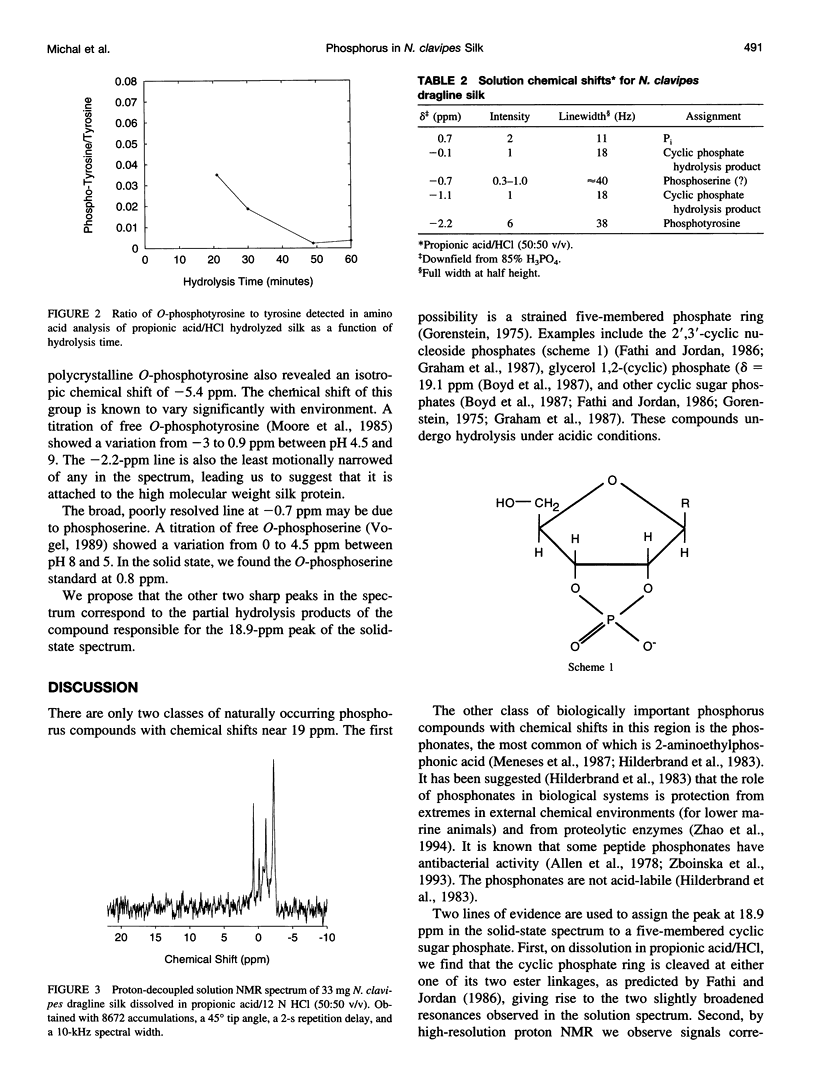Abstract
Solid-state 31P-NMR of Nephila clavipes dragline silk indicates the presence of phosphorus in at least two chemically distinct environments. Amino acid analyses of acid-hydrolyzed silk confirm the presence of phosphotyrosine as one of the phosphorus-containing components. The unusual chemical shift (18.9 ppm downfield from 85% H3PO4), proton chemical shift, and acid lability of a second component suggest that it is part of a strained five-membered cyclic phosphate that might be found on a beta-D-ribose. The five-membered cyclic phosphate is not removed from the silk fibers by exhaustive aqueous extraction. It is absent in nascent silk fibroin from the glands, suggesting that its formation is part of the fiber processing that occurs in the ducts leading to the spinnerets. High-resolution NMR spectra of silk dissolved in propionic acid/12 N HCl (50:50 v/v) show five phosphorus sites assigned to phosphorylated tyrosine residues, phosphorylated serine residues, inorganic phosphate, and two hydrolysis products of the cyclic phosphate compound. The observed posttranslational phosphorylation may be important in the processing and modulation of the physical properties of dragline silk.
Full text
PDF




Selected References
These references are in PubMed. This may not be the complete list of references from this article.
- Allen J. G., Atherton F. R., Hall M. J., Hassall C. H., Holmes S. W., Lambert R. W., Nisbet L. J., Ringrose P. S. Phosphonopeptides, a new class of synthetic antibacterial agents. Nature. 1978 Mar 2;272(5648):56–58. doi: 10.1038/272056a0. [DOI] [PubMed] [Google Scholar]
- Boyd R. K., DeFreitas A. S., Hoyle J., McCulloch A. W., McInnes A. G., Rogerson A., Walter J. A. Glycerol 1,2-cyclic phosphate in centric diatoms. Observation by 31P NMR in vivo, isolation, and structural determination. J Biol Chem. 1987 Sep 15;262(26):12406–12408. [PubMed] [Google Scholar]
- Graham R. A., Meyer R. A., Szwergold B. S., Brown T. R. Observation of myo-inositol 1,2-(cyclic) phosphate in a Morris hepatoma by 31P NMR. J Biol Chem. 1987 Jan 5;262(1):35–37. [PubMed] [Google Scholar]
- Heinrikson R. L., Meredith S. C. Amino acid analysis by reverse-phase high-performance liquid chromatography: precolumn derivatization with phenylisothiocyanate. Anal Biochem. 1984 Jan;136(1):65–74. doi: 10.1016/0003-2697(84)90307-5. [DOI] [PubMed] [Google Scholar]
- Jelinski L. W., Torchia D. A. Investigation of labeled amino acid side-chain motion in collagen using 13C nuclear magnetic resonance. J Mol Biol. 1980 Apr;138(2):255–272. doi: 10.1016/0022-2836(80)90286-7. [DOI] [PubMed] [Google Scholar]
- Moore R. R., Burt C. T., Roberts M. F. Observation of tyrosine-O-phosphate in Drosophila melanogaster larvae by 31P-NMR spectroscopy. Biochim Biophys Acta. 1985 Sep 30;846(3):394–397. doi: 10.1016/0167-4889(85)90011-4. [DOI] [PubMed] [Google Scholar]
- Nicholson L. K., Asakura T., Demura M., Cross T. A. A method for studying the structure of uniaxially aligned biopolymers using solid state 15N-nmr: application to Bombyx mori silk fibroin fibers. Biopolymers. 1993 May;33(5):847–861. doi: 10.1002/bip.360330513. [DOI] [PubMed] [Google Scholar]
- Vogel H. J. Phosphorus-31 nuclear magnetic resonance of phosphoproteins. Methods Enzymol. 1989;177:263–282. doi: 10.1016/0076-6879(89)77015-4. [DOI] [PubMed] [Google Scholar]
- Zboińska E., Lejczak B., Kafarski P. Antibacterial activity of phosphono peptides based on 4-amino-4-phosphonobutyric acid. FEMS Microbiol Lett. 1993 Apr 1;108(2):225–230. doi: 10.1111/j.1574-6968.1993.tb06103.x. [DOI] [PubMed] [Google Scholar]
- Zhao Q., Kovach I. M., Bencsura A., Papathanassiu A. Enantioselective and reversible inhibition of trypsin and alpha-chymotrypsin by phosphonate esters. Biochemistry. 1994 Jul 5;33(26):8128–8138. doi: 10.1021/bi00192a018. [DOI] [PubMed] [Google Scholar]


